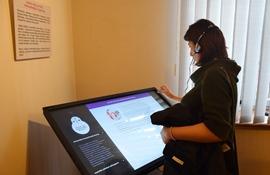On February 1, the Media Initiatives Center launched a new exhibition entitled “Media Battle vs. Corruption” as part of its Lratun (house of news) Museum project.
Through mobile exhibitions, Lratun presents the history of media coverage of significant events in Armenia, as well as the development and challenges of media and journalism. The goal of the Lratun project is to promote media literacy and encourage critical thinking among the general public, help shape savvy media consumers, and elevate the reputation of journalism.
“Lratun is an intersectoral, interdisciplinary, interactive and multimedia project, which integrates the history of the media, coverage of various sectors, museum culture, and modern technologies. This is one of our pilot projects aimed at voicing important, often sore issues through new media tools and platforms. This time, we are presenting media coverage of corruption cases and the journalists’ work in this area,” noted Nouneh Sarkissian, Managing Director of the Media Initiatives Center during the public launch of the exhibition.
Lratun project started in 2010 as part of the Alternative Resources in Media program, funded by USAID. The first exhibition was devoted to the journalists’ work during the Spitak earthquake of 1988. Apart from Yerevan, the exhibition also traveled to Gyumri, Vanadzor, Martuni and Kapan, attracting some 3,000 visitors.
Speaking at the event, U.S. Ambassador to Armenia Richard Mills, Jr. said: “One of our Embassy's top priorities is to support the efforts of the Armenian government and civil society to fight corruption. And as this exhibition shows, free and independent media play an instrumental role in exposing corruption when it occurs. A free press is essential for holding officials accountable, and for keeping the public informed when taxes meant for public goods and services are misused for private gain.”
The authors of the “Media Battle vs. Corruption” exhibition have highlighted seven most well-known cases of corruption in the areas of justice, foreign investments, army, telecommunications, elections, energy, and offshore operations.
“This is not an ordinary exhibition, where you browse through the exhibits and leave. This is an opportunity to become part of a journalistic adventure and investigate seven notorious cases of corruption. Some visitors are also likely to come back to get a sense of the bigger picture of corruption coverage through interviews with journalists and experts, satirical posters, TV programs, films, and media reportage,” said Vahram Martirosyan, Lratun Project Manager.
In addition to the feature exhibition, the mobile museum offers its visitors, especially high school and university students, to hone their analytical and critical thinking skills through other tools. Media Initiatives Center’s Media Battle, Tsantsar and Adventures of Literatus games are there to test and improve the visitors’ media literacy, while the simulation room will allow them to ‘broadcast’ from any part of the world. The exhibition will run in Yerevan in Sargis Muradyan Gallery (38 Isahakyan Street) through February 18, 2018. In March and April, the exhibition will travel to Gyumri, Vanadzor and Goris.
The Lratun Media Museum is a project of the Media Initiatives Center and is made possible by the support of the American people through the United States Agency for International Development (USAID) within the framework of the Media for Informed Civic Engagement project.

Armine Karabekian, USAID/Armenia
